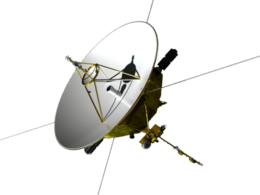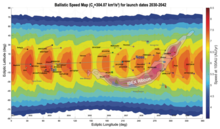Interstellar (space probe)
 Artist's rendering of Interstellar spacecraft (plasma wave antennas extend far beyond portion shown) | |
| Mission type | Outer planetary, heliosphere, and interstellar medium exploration |
|---|---|
| Operator | NASA / Johns Hopkins Applied Physics Laboratory |
| Website | interstellarprobe |
| Spacecraft properties | |
| Launch mass | 860 kg (1,900 lb) |
| Power | 470 watts (at launch) |
| Start of mission | |
| Launch date | 2036 |
| Rocket | Space Launch System Block 2 |
| Flyby of Jupiter | |
| Closest approach | 2037 |
| Distance | ~4 000 km |
Flagship | |
Interstellar (abbr. ISP) is a proposed NASA space probe designed to explore and characterize the heliosphere and interstellar space. The study was originally proposed in 2018 by NASA for the Applied Physics Laboratory, and would have a baseline launch between 2036 and 2041.[1] The probe would launch on a direct hyperbolic trajectory to encounter Jupiter after six to seven months, after which the probe travel at a speed of about 6–7 astronomical units (900,000,000–1.05×109 kilometres) per year, leaving the heliosphere after only 16 years. The probe may also have the opportunity to encounter minor planets on the way out, including Orcus and Quaoar, though such flybys would require specific launch dates. With next-generation radioisotope thermoelectric generators, (RTGs), the mission would be designed to last for over fifty years after its launch, a similar feat reached by the Voyager 1 and 2 probes despite their intended 5-year lifetime.[2]
Mission background[]
History[]
Interstellar probes such as the Voyager program were made only with the intent to visit the outer planets, with the added interstellar mission as a mere bonus. Their lifetime had never been expected to be much longer than 12 years at the most, but the probes have lasted for upwards of four decades thus far. Both Voyagers left the heliosphere in the 2010s; Voyager 1 in 2013,[3] and 2 in 2018,[4] and while their readings have been valuable, many of their instruments have been shut off due to a lack of power in their RTGs. In addition, neither of them are headed toward the IBEX ribbon, a region discovered by the Interstellar Boundary Explorer where energetic neutral atoms (ENAs) seem to highly affect the heliosphere and are able to breach it at unprecedented rates.[5]

Scientific payload[]
The probe would contain two differing scientific payloads, both weighing about 85–90 kg (187–198 lb). One would prioritize science, whereas the other would prioritize visible and infrared imaging of flyby targets.[1] Payloads highlighted in red are exclusive to the baseline payload; instruments in green are intended for the augmented flyby payload.
| Instrument (abbr.) | Dimension, range, resolution | Heritage |
|---|---|---|
| Magnetometer (MAG) | Electromagnetic radiation: 0.01-100 nT |
Magnetospheric Multiscale: DFG |
| Plasma Waves (PWS) | Plasma wave observations: ~1 Hz – 5 MHz, ≤0.7 µV/m at 3 kHz, ∆f/f ≤ 4%, ≤60 s full spectrum |
Van Allen: EFW |
| Plasma Subsystem (PLS) | Ion spectrometer: < 3 eV/e to 20 keV/e |
Parker Solar Probe: SWEAP, Span-A |
| Pick-Up Ions (PUI) | Ion counter: 0.5–78 keV/e | Ulysses: SWICS |
| Energetic Particles (EPS) | Ionization analysis: 20 keV – 20 MeV | Parker Solar Probe: IS☉IS, EPI-Lo |
| Cosmic Rays (CRS) | Cosmic ray analysis: H to Sn; 10 MeV/nuc – 1 GeV/nuc | Parker Solar Probe: IS☉IS, EPI-Hi |
| Interstellar Dust Analyzer (IDA) | Dust analysis: 1e−19 to 1e−14 g | Interstellar Mapping and Acceleration Probe: IDEX |
| Neutral Mass Spectrometer (NMS) | H, 3He, 4He, 14N, 16O, 20Ne, 22Ne, 36Ar, 38Ar, m/Δm ≥ 100 | Jupiter Icy Moons Explorer: NMS |
| Energetic Neutral Atom Imager (ENA) | Images emission of energetic neutral atoms; ~1–100 keV H | Interstellar Mapping and Acceleration Probe: IMAP-Ultra |
| Lyman-Alpha Spectrograph (LYA) | Mapping solar wind interactions with interstellar medium: ±100 km/s Doppler range, <10 km/s resolution |
MAVEN: IUVS |
| Visible-Near-IR (VIR) | Flyby imaging: 0.4–4 µm; ≥ 5 ch. ≤0.975 µm >240 ch. >0.975 µm |
New Horizons: Ralph |
| Visible-IR Mapper (IRM) | Infrared mapping: 0.5–15 µm 30–100 µm |
New Horizons: LEISA, CIBER-2 |
References[]
- ^ a b McNutt, Ralph; Paul, Michael; Brandt, Pontus; Kinnison, Jim. "Interstellar Probe: Humanity's Journey to Interstellar Space" (PDF). Interstellar Probe. Johns Hopkins Applied Physics Laboratory. Retrieved 23 December 2021.
- ^ Amos, Jonathan. "Interstellar probe: A mission for the generations". www.yahoo.com. BBC. Retrieved 23 December 2021.
- ^ "Interstellar Mission". NASA Jet Propulsion Laboratory. Retrieved August 24, 2020.
- ^ University of Iowa (November 4, 2019). "Voyager 2 reaches interstellar space - Iowa-led instrument detects plasma density jump, confirming spacecraft has entered the realm of the stars". EurekAlert!. Retrieved November 4, 2019.
- ^ Baldwin, Emily (October 15, 2009). "IBEX maps edge of Solar System". Astronomy Now. Retrieved August 14, 2016.
External links[]
![]() This article incorporates public domain material from websites or documents of the National Aeronautics and Space Administration.
This article incorporates public domain material from websites or documents of the National Aeronautics and Space Administration.
- Space program of the United States stubs
- NASA space probes
- Proposed space probes
- Missions to Jupiter
- Missions to minor planets




